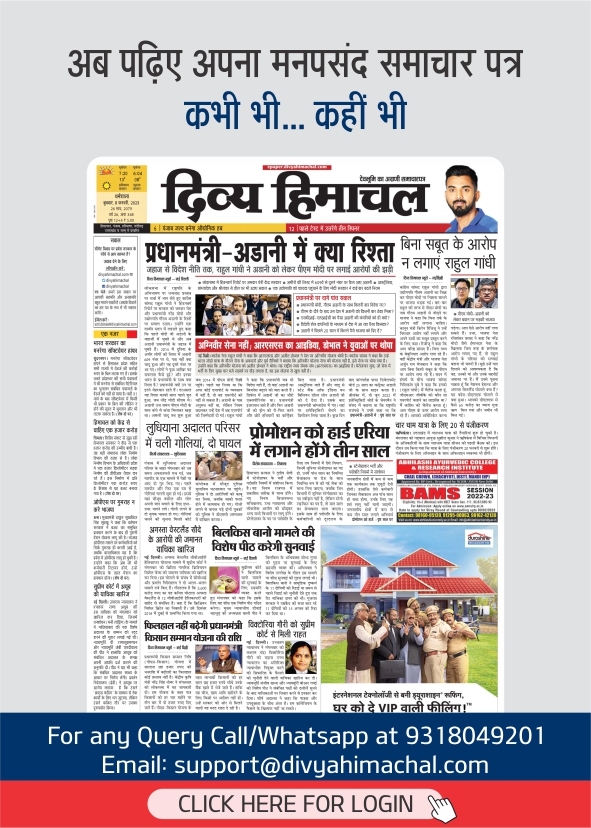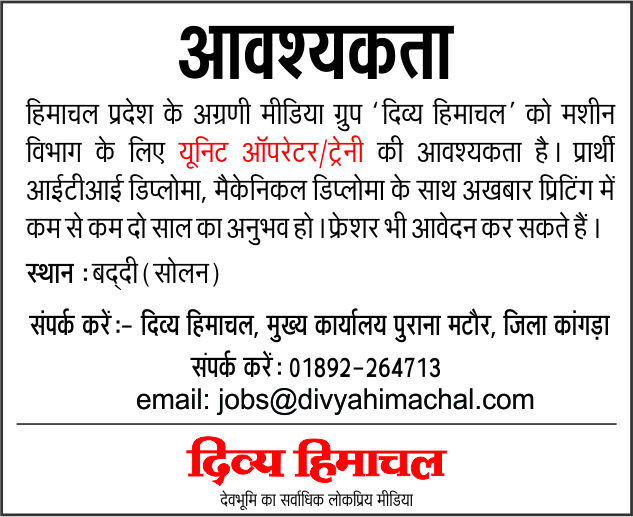Himachali’s Health Promoting School
Y.S. Rana
The writer is a Hamirpur based Himachali settled in Chandigarh

Dr Thakur says, “If we really want to stop spread of non-communicable diseases, we should have strong health promoting system for schools, workplaces and at community levels”. With funds from World Health Organisation (WHO), he had developed health promoting models for workplace and community setting level. On the basis of his study, he has recommended at least 20-week of healthy lifestyle promoting intervention package to school curriculum in each academic year for sustainable impact and behavioural change to reduce the burden of lifestyle disorders in school-going children. He has evolved an accreditation manual for HPS and drafted it after discussion with key stakeholders, and a qualitative analysis of the stakeholders’ meeting outcome which has generated 26 parameters for accreditation checklist for HPS. On the basis of this, a scoring system included all 26 parameters which was developed with 1 to 3 points award to each parameters. On the basis of score, each school would be graded in gold, silver,bronze and platinum, he stated.
Dwelling on the pattern of scoring, he said that cut off score of 100-120; 121-150; 151-200 and more than 200 points of a school would be categorized as bronze, silver, gold and platinum levels respectively. For purpose of accreditation of the school, he said that the Quality Council of India has also been approached and its involvement in the project would be sought. He further stated that 26 parameters have been classified into eight specific domains. The tool was pilot-tested in eight schools and the realiability score of the checklist was 0.7. He further stated that he would approach state governments to introduce this model in schools. “Non-communicable diseases are making inroads in inhabitants even in children,” he says. He has also developed district health promoting model and it has been introduced in two districts and also working on developing such model at city level. Dr Thakur says that the primary objective of the study was to examine the impact of multi-composed lifestyle interventions on weight and body mass index (BMI) of school children. He said that the state while drafting its action plan should incorporate health promoting measures with main focus at school, workplace and community levels. He has prepared a fact sheet about non-communicable diseases in Chandigarh and revealed that 14% of population was diabetic and added that city topped in breast cancer, and lung cancer was more prevalent among males of the region.
Vast Field Experience
Born in district Una of Himachal Pradesh, Dr. J.S. Thakur did his MD in community medicines from Indira Gandhi Medical College, Shimla in first division. He has vast experience behind him about non-communicable diseases. He had also been associated with World Health Organisation for South-Asian countries. He is also consultant for centre and state governments in matters of policy, programme and control of non-communicable diseases. Besides this, he has also written a book on public approaches to non-communicable diseases which was forwarded and released by the Union Health Minister J.P. Nadda recently.
Non-communicable diseases are linked to our behaviour and around 80% of heart, diabetes, stroke and 70% of cancer diseases can be prevented by adopting healthy lifestyle
– Dr. J.S. Thakur, Professor of Community Medicines School of Public Health, PGI, Chandigarh
Himachal-o-Meter
The state’s ups and downs this week
Four Fish Processing Units in Himachal
Shimla: To bring blue revolution in Himachal Pradesh, the state government will set up four fish processing units under the technical assistance of the Central Institute of Technology, Kochin. These units will be set up at Bhakra (Gobind Sagar), Khatiar (Pong Dam), Katauhad Kalan (Una) and Ratyod (Solan). According to the state spokesperson, the Fisheries Department is earning more than Rs. 4 crore annually. During the last four years, 428,81.475 mt fish worth Rs. 38,994.6 lakh were produced from all existing water resources of the state. Fish products like fish pickle, fish filets, fish bowl and fish finger papad would be prepared in these units and would be made available in the market. As modern techniques would be used in the preparation of these products, these could be used even after a period of more than one year from the manufacturing date. In order to create more self-employment opportunities in this sector, various schemes amounting to over Rs. 35 crore were sanctioned and implemented during the last four years. Rs. 13 crore will be spent under the Blue Revolution scheme during this financial year. Under the scheme, hatcheries, fish farms, small and big fish ponds, fishery feed units and trout units are being established.
Tribal Bhawan At Chamba In Pitiable Condition
Chamba: Tribal Bhawan at Baloo, on the outskirts of Chamba, seems to be crying for maintenance work. It is in pitiable condition these days and the department has failed to repair the building. Roof of the building is crumbling and the toilets inside the building stink. Notably, the tribal residents stay at concessional rates in this building when they come to the district headquarter for their work. The assignment of looking after the Tribal Bhawan has already been entrusted to the Bharmour Division of the Himachal Pradesh Public Works Department (HP PWD). Since this division of the PWD is located far away from the Chamba district headquarters, maintenance of the building could not be done on time. Pangi Kalyan Sangh, a body representing the tribal people, recently met Chamba Deputy Commissioner Sudesh Mokhta and apprised him of the deplorable condition of the building. Delegation of the sangh, led by its president PL Thakur, urged the DC that maintenance work of the Tribal Bhawan should be handed over to the Chamba Division PWD so that its condition could be improved from time to time. They also demanded some budgetary provisions for the upkeep of the building.
Keep watching our YouTube Channel ‘Divya Himachal TV’. Also, Download our Android App













